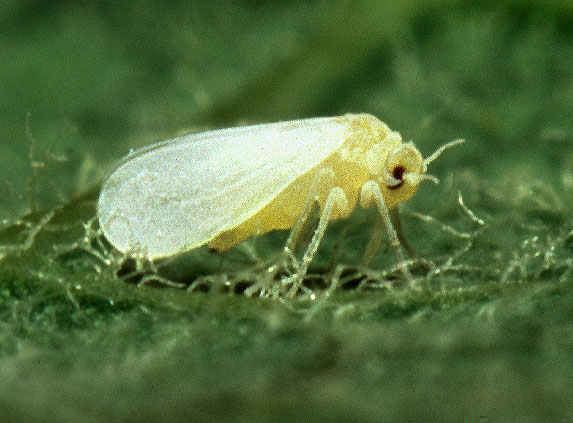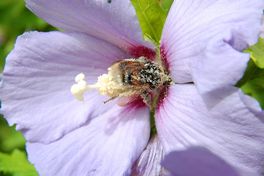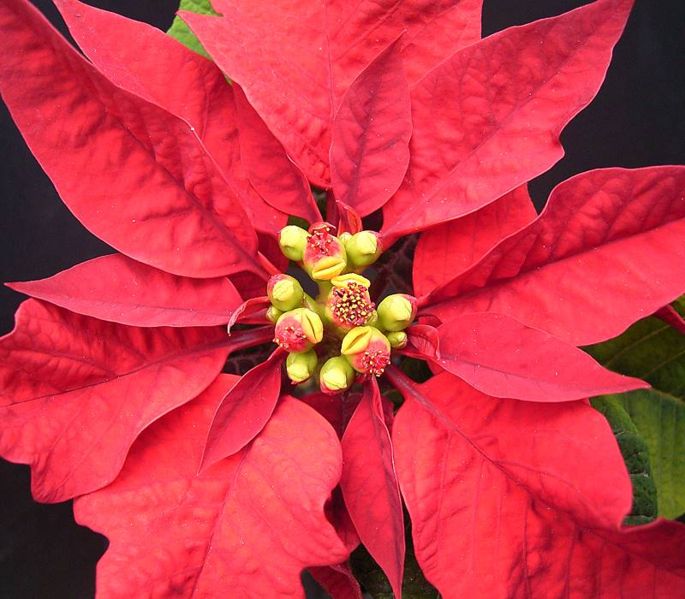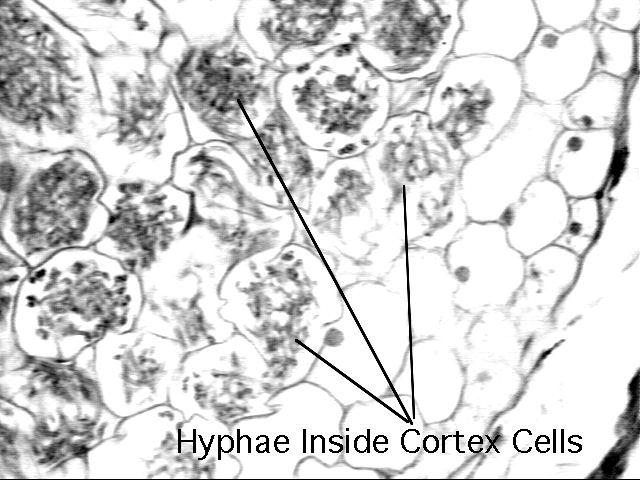The Poinsettia and the Whitefly
As previously mentioned,
the poinsettia's diterpene esters (toxins) cause
 it to have few natural predators.
The whitefly is the exception.
Numerous species of whiteflies including the Greenhouse whitefly (Trialeurodes vaporariorum),
the Sweet Potato whitefly (Bemisia tabaci), and the Silverleaf whitefly
(Bemisia argentifolii)
act as parasites to Euphorbia pulcherrima. They can do so in a few ways.
After landing on
the plant, the whitefly will generally position itself on the
underside of the poinsettia's leaves. There, they will either
being to consume the leaves or infiltrate the vascular system and absorb sugars
and other nutrients directly
from the phloem. Either case causes
great damage to the plant. A
female whitefly can further parasitize
the poinsettia by laying her eggs (60 to 100 depending on the species)
on the underside of the
leaves of the poinsettia. When the eggs hatch, the nymphs continue to feed
on the poinsettia's leaves.
it to have few natural predators.
The whitefly is the exception.
Numerous species of whiteflies including the Greenhouse whitefly (Trialeurodes vaporariorum),
the Sweet Potato whitefly (Bemisia tabaci), and the Silverleaf whitefly
(Bemisia argentifolii)
act as parasites to Euphorbia pulcherrima. They can do so in a few ways.
After landing on
the plant, the whitefly will generally position itself on the
underside of the poinsettia's leaves. There, they will either
being to consume the leaves or infiltrate the vascular system and absorb sugars
and other nutrients directly
from the phloem. Either case causes
great damage to the plant. A
female whitefly can further parasitize
the poinsettia by laying her eggs (60 to 100 depending on the species)
on the underside of the
leaves of the poinsettia. When the eggs hatch, the nymphs continue to feed
on the poinsettia's leaves.
The poinsettia is known to form some mutualistic (both organisms are benefitted) relationships with fungi. However, these fungi are not in the mushroom form that we typically associate with a fungus. Rather, these fungi that grow on and around the poinsettia's roots known as mycorrhizae. While mycorrhizae benefit by being portioned some of the poinsettia's photosynthetically produced sugar, the poinsettia receives outside nutrients that the fungus uptakes and brings back into the root cells. Mycorrhizae engaged in this type of relationship with a different plant can be seen at right.
The Poinsettia and Birds/Insects
 Poinsettias and many birds
and insects engage in a mutualistic relationship. Being a flowering
plant, the poinsettia's
flowers produce nectar and after being drawn in by the beautiful red bracts,
insects and birds may feed
on this nectar. Unknowingly, they are also benefitting the poinsettia.
While feeding, the organism
generally comes in contact with the pollen-producing stamen of the flower, during which time
pollen may be picked up by the organism. The organism will also contact
the female unfertilized
female flower. Here, pollen may be rubbed off, thus cross fertilizing the
poinsettia and helping it
reproduce with genetic variation.
Poinsettias and many birds
and insects engage in a mutualistic relationship. Being a flowering
plant, the poinsettia's
flowers produce nectar and after being drawn in by the beautiful red bracts,
insects and birds may feed
on this nectar. Unknowingly, they are also benefitting the poinsettia.
While feeding, the organism
generally comes in contact with the pollen-producing stamen of the flower, during which time
pollen may be picked up by the organism. The organism will also contact
the female unfertilized
female flower. Here, pollen may be rubbed off, thus cross fertilizing the
poinsettia and helping it
reproduce with genetic variation.
The Poinsettia and Humans

The poinsettia and human have a variety of relationships that can be good or bad depending on the perspective taken. From a negative aspect, humans can be predators to the poinsettia by sometimes causing their demise when removing them from their natural environment. Additionally, the poinsettia can harm humans (and other organisms that attempt to eat them) with the toxins they produce. On the other hand, the relationship may also be mutualistic. While man enjoys the plant's beauty, the plant may in time adapt to cooler environments and grow naturally in such areas which could be beneficial to the species. Also, humans and the poinsettia are dependant on each other's byproducts. Humans use oxygen released by the poinsettia during photosynthesis to carry out respiration (also known as metabolism). The plant benefits by utilizing the carbon dioxide humans release as a byproduct of respiration during their photosynthesis process.
Website Created by Christine Vick
March/April 2009
Questions? Comments? Email me at vick.chri@students.uwlax.edu

